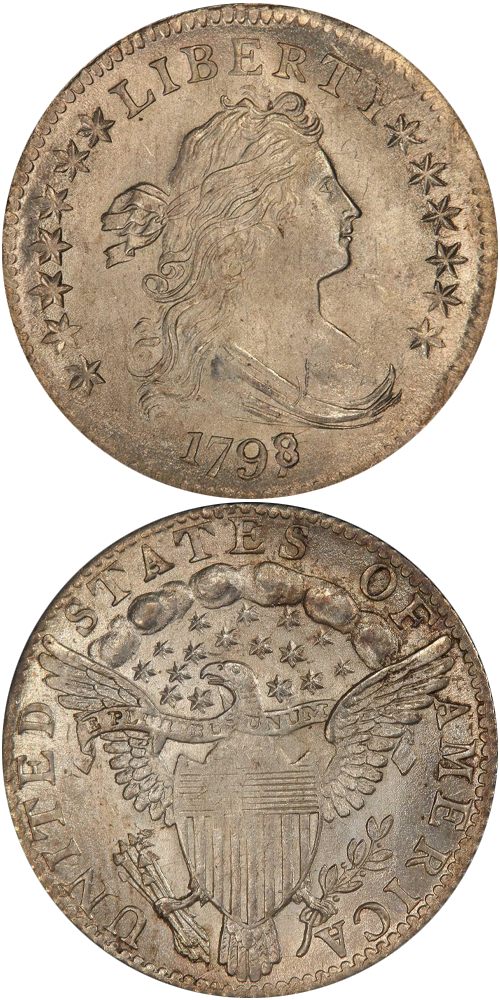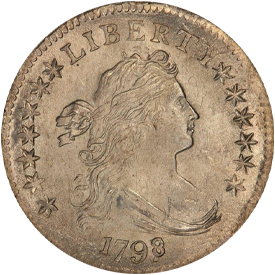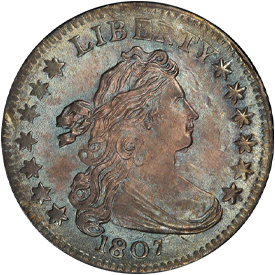Designed by: Robert Scot
Issue Dates: 1798-1807
Composition: 89.24% silver, 10.76% copper
Diameter: 19 mm
Weight: 2.69 grams (41.51 grains)
Edge: Reeded
Business Strike Mintage: 422,010
Proof Mintage: None
The dimes minted from 1798 through 1807 display the Draped Bust obverse as preceding, except that the star count is now standardized at a total of 13, with seven to the left and six to the right. The reverse is new and is designated as the Heraldic Eagle style. Patterned after the Great Seal of the United States, it features an eagle at the center, with a shield on its breast, and a ribbon bearing the inscription E PLURIBUS UNUM in its beak. Above is an arc of clouds, below which are stars. UNITED STATES OF AMERICA surrounds. There is no indication of value or denomination. A number of different die varieties exist within this range, including the overdates 1798/7 and examples with different numbers of stars above the eagle on the reverse.
In keeping with other early silver coins, examples most often seen are in grades from About Good through Fine. Very Fine pieces are somewhat scarce, Extremely Fine coins are scarcer yet, AU examples are rare, and Uncirculated coins are very rare. Many show Mint-caused adjustment marks. Areas of light striking are the rule, not the exception, and nearly all pieces have some flatness of stars or other details, with the lightness of strike generally increasing as the design continued in use; that is, specimens dated toward the end of the series, 1805 and later, are apt to be more lightly struck than those dated 1798.
Further Reading
In 1798 the design was changed to incorporate the Heraldic Eagle reverse. The obverse style remained the same. This motif was continued through 1807 inclusive. Coinage was intermittent, as it was with so many series in the early days, and dimes were not coined with the dates 1799 or 1806.
A number of varieties occur among 1798-1807 dimes. The 1798/7 overdate occurs in two varieties, one with 13 stars on the reverse and the other with 16. One variety of 1798 has an inordinately small 8 as the last digit. The most fascinating single variety in this date range, in my opinion, is the 1804 with 14 stars on the reverse. This particular coin was struck from the identical reverse die used to make 1804 quarter eagles with 14-star reverses! The use of a common die to strike two different coins of two widely separated denominations is very unusual, if not unique, in regular American coinage (however, this occurs a number of times in the pattern series). It has been suggested there might be some commonality among half dollar and $10 reverses of the 1801-1804 period, so perhaps exploration of this area will present some surprises in the future.
The Early United States Dimes 1796-1837 book notes that dimes bearing the date 1800 are much scarcer than collectors believed earlier and, further, "as a date, its frequency of appearance at public auction has been less than any date of the 1796-1837 period, except 1804.” Interestingly, of the specimens that survive, a number of them are in higher grades, with the result that, according to the same text, "locating a choice specimen for a collection is not too difficult a task.” Of course, this statement is relative. In terms of the frequency of appearance of late 19th-century dimes and 20th-century issues, high-grade 1800 dimes are indeed rare. However, in the context of dimes of the 1800 decade, high-grade 1800 dimes are encountered more frequently than are pieces of most other dates.
The opposite situation occurs with the following date, 1801. Most known specimens are well worn, and pieces in Uncirculated grade, or close to it, are very rare. Similarly, dimes dated 1802 are major rarities in upper condition echelons.
Although price guides do not necessarily reflect this, dimes of the next year, 1803, are also very rare in top grades. The Early United States Dimes 1796-1837 book notes, for example: "It is estimated that, at the most, ten 1803 dimes exist in full Extremely Fine condition or better.” Here, then, is a sleeper. What is the reason why the 1802 dime and certain of its contemporaries do not list for very high prices in higher grades? The answer is that most buyers are seeking a single piece for inclusion in a type set to illustrate the 1798-1807 Heraldic Eagle reverse style, and whether the piece is dated 1802 or whether it is dated 1807 does not make much of a difference. Of course, for the variety specialist this provides the remarkable opportunity of acquiring a rarity for little more than a commoner date would cost. The same illustration can be extended to several other varieties among dimes of the 1798-1807 years.
Dimes dated 1804 are encountered with some frequency, with the previously mentioned 14-star reverse issue being particularly interesting (but not necessarily difficult to locate). About one-third of the 1804 dimes appearing on the market are of this style. In Uncirculated grade, 1804 dimes are extreme rarities or are perhaps even nonexistent. The authors of Early United States Dimes 1796-1837 make the remarkable statement that no 1804 dime "has ever appeared at public auction in Uncirculated condition.”
Dimes of the final two years of the type, 1805 and 1807 (no pieces were made in 1806), occur with frequency. In general, examples dated 1805 tend to be better struck than those dated 1807. Uncirculated pieces exist of these dates and are seldom seen, although it should be noted that the previously cited Early United States Dimes 1796-1837 book notes concerning 1807: "Can easily be found in all grades, including MS-65 or better.” I believe that the term "easily" is relative and is stated in comparison to other dime issues of the 1798-1807 type. Certainly, these are not "easily found" in an absolute sense. I imagine one could offer to pay triple the going rate and place large advertisements in leading numismatic publications and be lucky to get just one or two pieces, if any.
One characteristic of dimes dated from 1798-1807 is that nearly all known specimens have lightness of striking or impression in one area or another. More often than not, the obverse rims show flatness in one or more areas, some or all of the stars are flat, and on the reverse there is rim weakness as well as imprecise definition of the stars above the eagle's head. This is to be expected; it is "par for the course," as they say. No grades are immune. Even the frostiest Uncirculated examples, of which not many exist of this type, are apt to show this. Dimes dated 1807 are particularly egregious in this regard, as noted earlier.
Although popular catalogues do not make any great differentiation among Uncirculated pieces-refer to my comment concerning the listing of the possibly non-existent 1804, for example. My experience is that issues of 1801, 1802, 1803, and 1804 are in particular extreme rarities in this preservation. Most often seen is the 1807, examples of which are poorly defined at the borders. In worn grades, dimes of the 1798-1807 style are readily available across the complete range of conditions from About Good through Very Fine, with certain issues being scarce or rare in Extremely Fine or better preservation.
A good number of Fair and Good coins exist, indicating that this denomination received intense use in circulation at the time. In an era in which there were few coin collectors in the United States, and in which what few collectors there were tended to ignore worn pieces, early dimes remained in circulation for a long time. Probably many pieces were in circulation through the early 1850s, at which time dimes and other silver denominations became worth more in melt-down value than face value, due to the rising price of silver metal. By this time, dimes of the 1798-1807 style had been in circulation for a half century!









